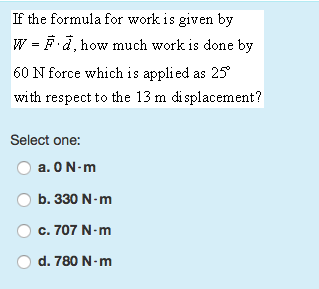

In general, the work done by force F is equal to the change in kinetic energy If 1 joule of work is done then the formula for work comes out to be 1 J = 1 N.m Derivation of Work FormulaĬonsider a block placed on a frictionless horizontal floor acted upon by a constant force F due to which this block moves through a distance d in a straight line in the direction of the force.

So this is how you might solve a problem applying the theorem of work energy theorem.The formula for work is used to calculate the work. So that is my net work that is required to accelerate that object from 2 meters per second to 4 meters per second. So I've got 4 squared is 16 times 3 is 48 and one half of 48 is 24 kilograms over meters per second squared and I'm going to subtract from that I've got 2 squared is 4 meters per second squared and times 3 is 12 and minus one half of 12 is 6 kilograms and if I subtract 6 from 24 I get 18 and this also equals this unit here kilograms over meters over seconds squared equals 18 joules of energy. Let's go ahead and solve for that problem alright? So my final kinetic energy is one half and my mass is 3 kilograms and my final velocity is 4 meters per second squared right? My initial velocity is, and so my initial kinetic energy is 3 kilograms times 2 meters per second squared alright, so let's go ahead and crunch these numbers and I got to have my one half times that, let's fix that before we move on. So I can use this formula where net work equals my final kinetic energy minus my initial kinetic energy. And I want to know what the net work is needed to cause that acceleration okay. Let's say I've got an object of 3, a mass of 3 kilogram object and I need to accelerate it from 2 meters per second to 4 meters per second. Let's look at a problem where you might be asked to use the work energy theorem to solve a problem related to net work okay.

So the net work is the change in kinetic energy or the final kinetic energy minus the initial kinetic energy. So let's review kinetic energy, remember kinetic energy which we'll abbreviate ke is one half the mass times the velocity squared okay. The work energy theorem, this is a theorem that states the net work on an object causes a change in the kinetic energy of the object.


 0 kommentar(er)
0 kommentar(er)
